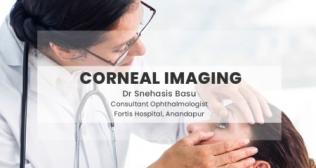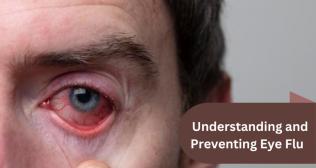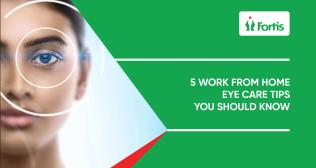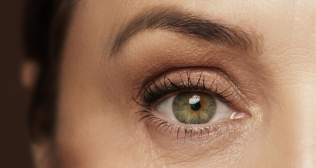
Best Cataract Surgery in Mumbai
Cataracts: Common symptoms, causes, types, treatment and prevention
Cataracts are a common eye condition in older adults, although they can also affect younger people. This condition occurs when cloudy or opaque areas form in your eye’s lens that are typically clear and transparent. It can affect one or both eyes, interfering with your vision and leading to blindness over time. Cataracts can usually be successfully treated with surgery. At Fortis Hospital, Mulund, our eye specialists offer expert treatment for patients requiring cataract surgery using the most advanced technology.
Read on to learn more about cataracts, including the signs and symptoms, causes, risk factors, types, treatment, prevention, and outlook.
What are cataracts?
Cataracts are a common condition in which the lens of your eye becomes blurry or cloudy, affecting your eyesight. Your eye’s lens, located behind the iris and pupil, is normally clear and helps to focus light. As you age, the protein (crystallins) in your lens breaks down. This causes a clouding of the lens, resulting in blurry, hazy vision, or seeing double. Worldwide, cataracts are a leading cause of blindness among adults. Fortunately, cataracts can often be treated with surgery.
What are the signs and symptoms of cataracts?
You may not have any symptoms in the initial stages because most cataracts develop gradually. But as they progress over time, you may notice a range of problems, including:
- Cloudy, blurry, foggy, or double vision
- Seeing colours as faded or yellow
- Seeing halos around lights
- Difficulty seeing clearly at night
- Sensitivity to glare – bright sunlight, headlights
- A frequent need to change prescription glasses
Consult an eye specialist if you notice any of these symptoms or changes in your vision.
What are the types of cataracts?
Cataracts are classified into several types, depending on where they form in your eye. Common types include:
- Nuclear cataracts – form in the nucleus, the center of the lens.
- Cortical cataracts – form in the cortex, the edges of the lens.
- Posterior subcapsular cataracts – form in the posterior cortex, the back of the lens.
- Congenital cataracts – present at birth or may develop as an infant or child. Congenital cataracts usually run in families, although they can be caused by various things such as infections, metabolic disorders, or injuries while in the womb. Congenital cataracts are less common than age-related cataracts.
Other types include secondary cataracts, traumatic cataracts, rosette cataract, and radiation cataracts.
What causes cataracts?
Cataracts are mostly caused by the gradual breakdown of proteins in the lens of your eye as you get older. However, certain factors can increase your risk of developing cataracts.
Risk factors for cataracts include:
- Increasing age – after the age of 40
- Spending a lot of time in the sun, especially without eye protection
- Long-term exposure to air pollution
- Having had radiation treatment on the upper body
- A family history of cataracts
- A sedentary lifestyle
- Smoking
- Excessive alcohol use
- Certain health conditions such as diabetes, high blood pressure, obesity, etc,
- Previous eye injury, inflammation, or surgery
- Certain medications, such as steroids
How are cataracts diagnosed?
Your eye doctor or ophthalmologist will perform an eye exam, as well as review your symptoms and medical history to make a cataract diagnosis.
They will also use several tests to diagnose cataract and other eye conditions, including:
- Refraction and visual acuity test – to measure the sharpness and clarity of your vision.
- Slit lamp exam – to assess your overall eye health.
- Pupil dilation – to examine the retina, using eye drops that dilate or widen the pupil for a clearer view.
How are cataracts treated?
At Fortis Hospital, Mulund, our eye specialists offer safe and effective cataract treatment, tailored to individual factors, such as your age, overall health, the type of cataract you have, and the severity of your symptoms.
Treatment options include:
Prescription eyeglasses: In the early stages of cataract, vision changes can be gradual. Your doctor may prescribe eyeglasses to help you see better, if the symptoms are not bothering you a lot, or if surgery is not required right away.
Surgery: Surgery is the most effective treatment option for most cataracts, especially when they interfere with your daily activities, such as reading or driving. During cataract surgery, your ophthalmologist will remove the clouded natural lens and replace it with a clear artificial lens, called intraocular lens (IOL). Cataracts can be removed using one of the two primary surgical options: traditional cataract surgery or laser-assisted cataract surgery.
At Fortis Hospital, Mulund, our eye specialists, who are experts in cataract surgery, can help you determine whether surgery is the right choice for you. If you decide to undergo cataract surgery, your doctor will thoroughly discuss a few things with you, including the pros and cons of the procedure and the most appropriate surgical option, based on your unique needs.
How safe is cataract surgery?
Cataract surgery is considered safe, with a very high success rate. Most patients experience improved vision and a better quality of life after surgery.
What are the risks or complications of cataract surgery?
Like any surgical procedure, cataract surgery carries a risk of complications – such as infection, bleeding, detached retina (retina being pulled out of place), vision loss, etc.
Can cataracts be prevented?
Cataracts are an inevitable part of ageing, meaning they can’t be entirely prevented. However, you can take steps to help protect your vision, reduce your risk, and slow the growth of cataracts:
- Eat a healthy diet that includes plenty of antioxidant-rich foods like carrots, dark green leafy vegetables, and citrus fruits.
- Maintain a healthy body weight.
- Do not smoke.
- Take alcohol in moderation.
- Wear sunglasses or eyeglasses that block UV radiation when outdoors.
- Get regular eye check-ups.
- Manage other health conditions such as diabetes, which is a risk factor for cataracts.
Outlook
Cataracts, in their early stages, may not cause noticeable symptoms. However, they can worsen over time and prevent you from carrying out your daily tasks, affecting your quality of life. Left untreated, they can lead to vision loss. The surgical removal of cataracts is highly effective, helping you see better and live a more fulfilling life.
If you’re concerned about your eye health or have a risk factor for cataracts, make an appointment with an eye doctor to take steps and protect your sight.
Categories
Clear allMeet the doctor

- Ophthalmology | Ophthalmology
-
28 Years
-
1400



















